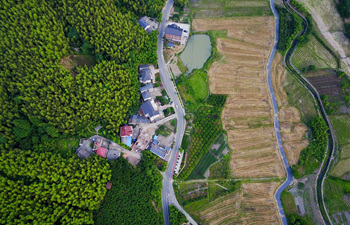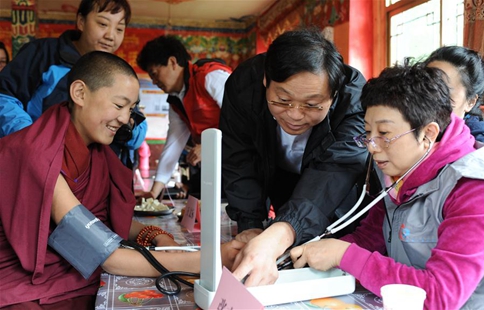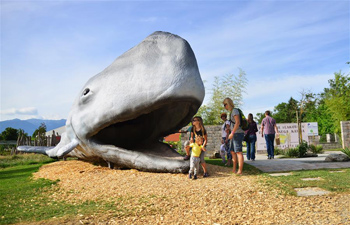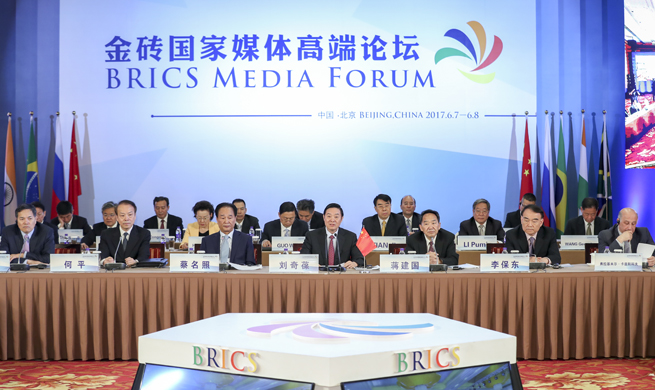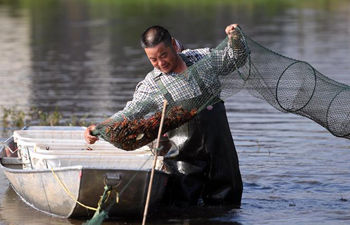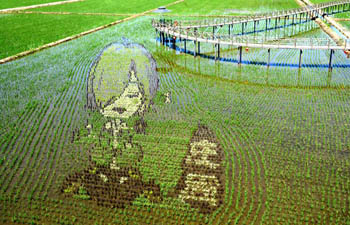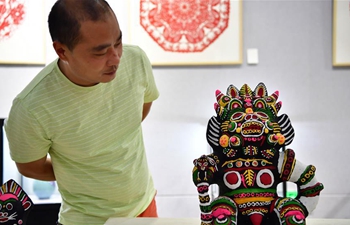WUHAN, June 9 (Xinhua) -- In the lead up to the China's Cultural Heritage Day that falls on Saturday, a series of short documentaries about a team of "magical" conservator-restorers has gone viral online.
The three five-minute episodes introduce the extraordinary work undertaken in a cultural relic restoration center in the city of Jingzhou in central China's Hubei Province. The documentaries have gained nearly a million views on the Weibo microblogging service and various mobile news applications.
Using cutting-edge technology and unparalleled techniques, the team of scientists led by chemist Wu Shunqing, 68, have stunned viewers with their repairs of ancient relics, revealing previously unknown historical data.
BAMBOO SLIPS
Before the invention of paper, bamboo slips were one of the most important conveyers of Chinese culture. The narrow strips of bamboo bound together by thread carrying lines of complex Chinese characters were a cherished find for archeologists and served as inspiration for an academic paper.
"However, they are easily mistaken for a pile of rotten soil as oxidation can turn bamboo black the moment it is unearthed," Wu said.
Thanks to his team and their unique skills, blackened strips can be restored to their original color and the ancient characters painted on them rediscovered.
Buried bamboo slips often remain submerged in mud and water for thousands of years. Even the gentlest of touches could destroy them. From excavation to cleaning, the process requires the level of care given to a newborn baby.
"Firstly we must soak a bamboo slip in distilled water to ensure it remains moist. Then a soft brush is used to remove mud and other substances from the slip," Wu said, adding that patience is key during the process.
Sodium dithionite, a decolorizing agent, is then used to return the bamboo to its original color without destroying the ink.
Drying out the bamboo slips posed a major challenge for restoration efforts during in 1990s. If slips were dehydrated too quickly, there was an increased risk of damage. To avoid this, Wu's team first soaked the slips in ethanol to support the interior structure of the bamboo and prevent them from cracking as they dried.
After the cleaning, decoloration and dehydrating processes are complete, the characters are once again visible and can be scanned and documented, before the bamboo slips are put on display for the public.
The center has restored more than 120,000 bamboo slips, accounting for70 percent of all water-logged bamboo slips unearthed in China.
"Currently we are working on thousands of bamboo slips excavated from Haihunhou Tomb, China's most complete Western Han Dynasty (206 B.C.- 25 A.D.) tomb. I believe major historic discoveries are waiting to be discovered when we allow the slips to speak again," Wu said.
LACQUERWARE
The Jingzhou Museum adjacent to the center houses is a precious treasure -- an ornate drum carried by a pair of long-necked birds each standing on the back of a crouching tiger.
"It was not just a burial artifact, but also a musical instrument, and an unusually fine example of lacquerware," Wu said.
The huge piece, marked by exquisite workmanship and the glowing colors of natural pigments, demonstrates the peak reached by Chinese lacquerware over 2,000 years ago.
However, when it was excavated in 2000, it was in a horrible condition. "The bird's beaks, wings and legs were either broken or rotten, and the drum could not stand on its own. It was disheartening look at," Wu recalled.
The water-logged drum was extremely fragile and was at risk of irreversible damage without careful restoration.
Due to the difficulty of safely removing the moisture, many pieces of excavated lacquerware were kept under water for decades, until Wu made a significant breakthrough.
He found that applying glyoxal, an organic chemical, during the dehydration process effectively preserved the original shape and color of the lacquerware.
The technique led the State Administration of Cultural Heritage to entrust the center with the restoration and preservation of 400 pieces of lacquerware unearthed from Mawangdui Han tombs in 1970s.
After moisture has been removed, experts apply natural pigments to restore the lacquerware's original colors.
This step is time consuming as six coats of paint are required, with each coat needing at least one week to dry before next can be added.
It took five years for the team to completely restore the drum.
More than 6,000 pieces of lacquerware unearthed across China have now been dried out and repaired using the scientist's technique.
SILK
Wu's team has also been exploring new techniques to restore ancient silk, an extremely delicate and complex task.
Silk does not preserve well and many pieces unearthed from tombs have already started to decompose or disintegrate. For example, unearthed silks from in the Warring States Period (475-221 B.C.) have usually started to rot after being buried for more than 2,000 years. Even if they survive excavation, the fragile textiles can easily be ruined, similar to bamboo slips.
Using unique biological technology, Wu and his colleagues have preserved with more than 500 pieces of silk, including a rare gown embroidered with birds and flowers.
In January 1982, archeologists found the gown amongst 152 pieces of silk inside a coffin unearthed from a Warring States Period tomb in Jingzhou.
In 2000, after years of research, Wu developed a technique of using microorganisms to eat away at hazardous substances on the textiles, such as mildew and salt crystals.
The State Administration of Cultural Heritage recognized the technique as "revolutionary" and "world-leading," honoring it with a national prize for innovation in cultural relic preservation in 2005.
The gown has been reinforced to the point where it is now foldable. The next step is to mend the damaged sections, before it can be put on display.
"The piece is so precious that we must be scrupulous about its repairs," said Wu. "Chemicals cannot be used. We're testing Pu'er tea as a dye."
In terms of restoration, every item presents a different set of circumstances, and a new task poses a unique challenge," Wu said.




